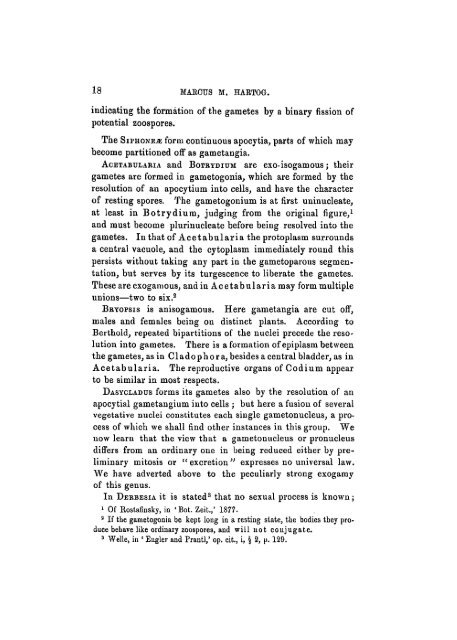Some Problems of Reproduction: a Comparative Study of ...
Some Problems of Reproduction: a Comparative Study of ...
Some Problems of Reproduction: a Comparative Study of ...
Create successful ePaper yourself
Turn your PDF publications into a flip-book with our unique Google optimized e-Paper software.
18 MARCUS M. HARTOG.<br />
indicating the formation <strong>of</strong> the gametes by a binary fission <strong>of</strong><br />
potential zoospores.<br />
The SIPHONED form continuous apocytia, parts <strong>of</strong> which may<br />
become partitioned <strong>of</strong>f as gametangia.<br />
ACETABULARIA and BOTBYDITTM are exo-isogamous; their<br />
gametes are formed in gametogonia, which are formed by the<br />
resolution <strong>of</strong> an apocytium into cells, and have the character<br />
<strong>of</strong> resting spores. The gametogonium is at first uninucleate,<br />
at least in Botrydium, judging from the original figure, 1<br />
and must become plurinucleate before being resolved into the<br />
gametes. In that <strong>of</strong> Acetabularia the protoplasm surrounds<br />
a central vacuole, and the cytoplasm immediately round this<br />
persists without taking any part in the gametoparous segmentation,<br />
but serves by its turgescence to liberate the gametes.<br />
These are exogamous, and in Acetabularia may form multiple<br />
unions—two to six. 2<br />
BRYOPSIS is anisogamous. Here gametangia are cut <strong>of</strong>f,<br />
males and females being on distinct plants. According to<br />
Berthold, repeated bipartitions <strong>of</strong> the nuclei precede the resolution<br />
into gametes. There is a formation <strong>of</strong> epiplasm between<br />
the gametes, as in Cladophora, besides a central bladder, as in<br />
Acetabularia. The reproductive organs <strong>of</strong> Codium appear<br />
to be similar in most respects.<br />
DASYCLADUS forms its gametes also by the resolution <strong>of</strong> an<br />
apocytial gametangium into cells ; but here a fusion <strong>of</strong> several<br />
vegetative nuclei constitutes each single gametonucleus, a process<br />
<strong>of</strong> which we shall find other instances in this group. We<br />
now learn that the view that a gametonucleus or pronucleus<br />
differs from an ordinary one in being reduced either by preliminary<br />
mitosis or " excretion" expresses no universal law.<br />
We have adverted above to the peculiarly strong exogamy<br />
<strong>of</strong> this genus.<br />
In DERBESIA it is stated 8 that no sexual process is known;<br />
1<br />
Of Rostafinsky, in ' Bot. Zeit.,' 1877.<br />
s<br />
If the gametogonia be kept long in a resting state, the bodies they produce<br />
behave like ordinary zoospores, and will not conjugate.<br />
a<br />
Welle, in ' Engler and Prantl,' op. cit., i, § 2, p. 129.

















